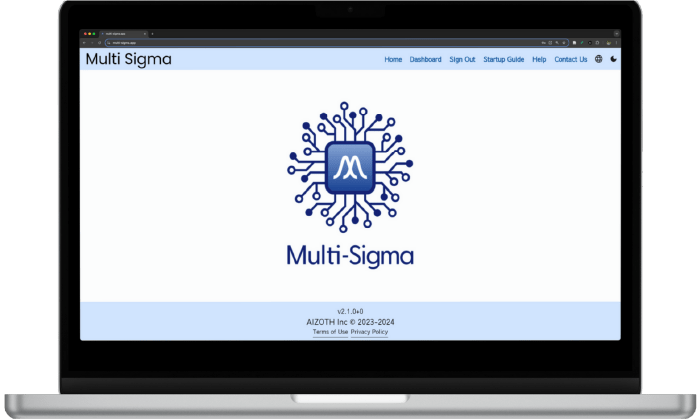Solution
Marketing
In the marketing domain, AI-driven analysis of data on customer behavior, market trends, and campaign performance is attracting significant attention as a powerful tool. Conducting exhaustive evaluations across all customer segments and market environments has become increasingly challenging given the growing complexity of the variables and interdependencies involved. Challenges are especially pronounced when analyzing data for low-frequency purchasers or campaigns that have produced only limited results. This article sheds light on these marketing-specific issues and presents approaches for building predictive models with Multi-Sigma® and for supporting
decision-making when working with sparse data.


1. Challenges in the Marketing Domain
a. The Complexity of Marketing Data and the Difficulty of Modeling
Modern marketing weaves together an extraordinarily diverse array of factors; online and offline touchpoints, multiple channels (such as social media, web advertising, and brick-and-mortar stores), timing, and even external conditions like the economic climate and seasonality. To understand how each of these elements influences the outcome of a marketing initiative, one must integrate fragmented multidimensional data and analyze it with sophisticated models. Achieving this is no easy feat. Looking across the entire organization, we also see significant cross-department interactions: marketing campaigns can affect sales and customer support, while price changes or product updates made by other departments can, in turn, alter the effectiveness of marketing efforts. Ignoring these interdependencies can sharply degrade the accuracy of campaign evaluations and demand forecasts. Traditional experimental approaches are often impractical as well; time and budget constraints make it unrealistic to test every possible condition. The diversity and unpredictability of customer behavior further complicate the construction of reproducible analytical models. As a result, the marketing field still faces many hurdles in leveraging data effectively for strategic planning.
b. Unclear Mechanisms of Customer Behavior
Consumers’ purchasing decisions are driven not only by price and brand awareness but also by complex, and often ambiguous factors such as emotions, social influences, personal lifestyles, and timing. When purchase frequency is low, as with high-ticket items or B2B offerings, the scarcity of behavioral data makes it extremely difficult to pinpoint what truly shapes those decisions. Consequently, analyses of why a campaign or advertisement succeeds or fails tend to lean on individual heuristics, creating structural hurdles that impede systematic improvement. There is a pressing need for analytical approaches that can objectively detect early signals of buying intent and enable marketers to act quickly.
c. Economic Losses from Inaccurate Demand and Response Forecasting
If companies cannot accurately predict the effectiveness of their marketing initiatives and consumers’ reactions in advance, they face significant financial losses, whether through excess or insufficient inventory, wasted advertising spend, or missed sales opportunities. In particular, over (or under) estimating demand when launching promotions or new products can lead to inventory write-offs or stock-outs, harming customer satisfaction and brand value. Likewise, shortcomings in targeting or segmentation can prevent optimal reach to prospective customers, consuming budget without generating results. In short, uncertainty in forecasts can erode marketing ROI and pose a serious threat to sustainable business operations.
2. What Multi-Sigma® Can Solve in Marketing

a. High-Accuracy Modeling from Small Data & Cross-Departmental Analysis
Multi-Sigma® can flexibly handle up to 200 explanatory variables. This capability enables you to include a broad spectrum of factors in your predictive models, ranging from ad tactics, customer attributes, purchase histories, and web behavior data to external variables such as weather and economic indicators. As a result, you can design multi-faceted, practical models that account for influences traditional analyses often overlook. Proprietary algorithms further boost predictive accuracy, making it possible to build reliable AI (machine-learning) models even when only limited data are available. That means you can obtain actionable forecasts during the early stages of an initiative, when data are sparse, or in scenarios constrained by budget or testing opportunities. In addition, Multi-Sigma’s unique AI Linkage Analysis technology enables deep insight into interdependencies that span multiple departments and business domains. By linking AI models built for individual departments, the platform supports comprehensive analyses that capture, for example, how price changes, product upgrades, or promotional activities in one area causally affect outcomes in another. This holistic view breaks down data silos, making it possible to design strategies with a full marketing ecosystem perspective and to prioritize factors based on their cross-initiative impact. In large organizations especially, Multi-Sigma® serves as a powerful foundation for enterprise-wide, data-driven decision-making.

b. Quantitative Understanding of Complex, Non-Linear, and Interactive Factors
The drivers of customer behavior rarely stem from a single variable; more often they arise from intricate interactions and non-linear relationships among many factors. Because Multi-Sigma® can incorporate up to 200 explanatory variables, it is able to model these higher-order interactions as well. This makes it possible to quantify condition-specific effects, for example, coupons outperform ads for highly price-sensitive segments or search advertising outperforms social media in certain product categories. When analysis suggests that purchase behavior or campaign response differs across segments, Multi-Sigma® can also build separate machine learning models for each segment. Ordinarily, segment level modeling runs into data sparsity, which degrades accuracy, but Multi-Sigma® employs proprietary patented techniques that still deliver high-precision forecasts from small datasets, giving segmentation analysis real power. With Multi-Sigma®, tasks that once relied heavily on expert intuition, identifying key drivers, and gauging their influence, can now be replaced by a more rational data-driven approach. This not only increases the objectivity and reproducibility of decisions but also serves as an analytical foundation that complements and strengthens expert judgment.

c. High-Precision Forecasting and Supply–Demand Optimization with Small or Skewed Datasets
Marketing performance indicators such as sales and ad response often rely upon data that are imbalanced or available in only a few cases. Multi-Sigma® is equipped with algorithms that preserve accuracy even for low-frequency patterns and biased datasets. This makes it possible to predict demand and customer reactions with high precision in data-sparse situations, for instance, an initial campaign for a new product, seasonal items, or limited-time promotions. Using these forecasts, companies can optimize production, logistics, and advertising budgets in advance, minimizing inventory risks and opportunity losses. Because the model can also ingest time-series data, it is also able to lend itself to medium and long-term strategy planning and price adjustment simulations.



